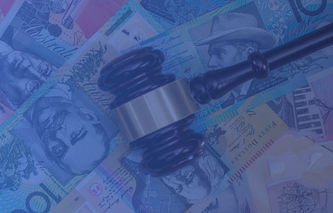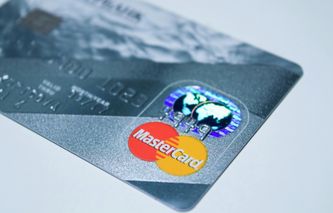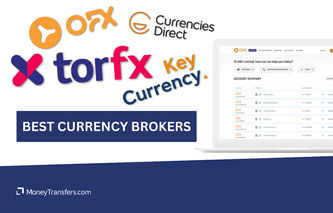Money transfer companies provide secure, fast, and often cheaper ways to send money internationally, ideal for both personal and business use. They offer features like real-time exchange rates, low fees, and multiple delivery options. Popular companies include Wise, Xe, and RegencyFX.
Using your bank for international transfers is costly due to poor exchange rates and high fees.
Thankfully, there are better alternatives available.
My selection of the top money transfer companies
"Over 16 million customers use Wise, mostly for their excellent mobile app, transparent fee structure & use of mid-market rates. Now increasingly used for larger transfers."
"Regency's UK-based account management team has vast experience. Get support on all kinds of transfers, from overseas property transactions to business payments & more."
"Xe has over 30 years of currency exchange experience, and is one of the most reputable names on the market. 200 countries, 100 currencies, & funds often received in seconds."
"OFX have been helping individuals and businesses send money for over 25 years. Transfer in 50+ currencies to 170+ countries, with 24/7 phone access to currency experts."
"Most transfers are instant or same-day. Customers can earn rewards on every transaction."
"Revolut has 50+ million customers globally. You can hold up to 36 currencies in the app and send money quickly in 70+ currencies to 160+ countries."
"Remitly focuses on sending money to friends and family in Asia, Africa and South America. Wide coverage and well-suited to regular transfers home."
"24/7 live chat support provided in six languages. Special first transfer rates available, with airtime topup supported to many countries in Africa, Asia and South America."
"TorFX's 5-star service handles most currency needs, especially relating to overseas property, emigration & retirement. Friendly phone support, no-obligation advice & no max transfer limit."
"Currencies Direct have over 30 years of global money transfer expertise. Award winning service with a TrustPilot rating of 4.9. Lock-in rates for the future or trade 24/7 on web or mobile."
"Key Currency offers a personal service with a dedicated account manager. There are no transfer limits or fees which is perfect for larger send amounts."
Business choices
"Airwallex offers a comprehensive financial platform for businesses. Make global transfers to 150+ countries, receive funds in 20+ currencies. Connect with popular software for a seamless approach."
"Sokin is a global payments platform for businesses. Hold 75+ currencies with free IBAN accounts. Make up to 5,000 payments per batch transfer. Excellent ecommerce payment gateway available."
Specialist money transfer companies offer:
Better exchange rates
Low or no fees
A mix of online and managed service
In this guide, I have compiled the top 10 international money transfer companies. I have detailed their pros and cons, rates, and key attributes to help you make an informed decision.
Who is the best and why
A money transfer company facilitates a transfer from one country to another. They are different from banks or payment apps in that they often offer more competitive rates.
Money transfer companies fit into two categories - online-only providers and managed services.
The most suitable money transfer company for you will depend on your specific transfer. This table gives an idea of how these two options generally compare:
For smaller transfers from the US, Wise is your top choice. You won’t have access to their multi-currency card yet (it’s coming soon), but you can use Revolut as an alternative.
For larger transfers, currency brokers are not as popular in the US as in the UK, but you still have many options: Regency FX, Currencies Direct, and XE.
Type of money transfer company | Quote | Best for | Transfer method | Recommended company | Check rates |
|---|---|---|---|---|---|
Online only | Instant | Smaller transfers | Self-service in the login area | ||
Manged service | Cusomt | Larger transfers | Email or phone, with an account manager | ||
Business platform | Varies | Companies doing business across borders | Self-service + account manager support | ||
Multi-currency account | Instant | Payments abroad | Self-service through the app |
Trusting our data
Our search results include over 50 providers, more options than many others on the market.
To compile this money transfer companies list I have also looked at banks and PayPal to give you the full picture of sending money abroad.
In every article, I cover fees, exchange rates, user reviews, online feedback, and supported currencies. This is to ensure I provide you with all the possible information on each company.
Every transfer is different and I’d always recommend searching for the amount you want to send, and where you want to send it to. This will give you a live price on a specific transfer.
Each money transfer company in detail
Below, I've outlined the top money transfer companies and why I like them in more detail. I've also provided some key information on how they made the top 10 list.
As with any money transfer, I would recommend carrying out a search based on the specific requirements of your transfers.
Wise is listed as the best money transfer company in the market. For me, it is the go-to option in several scenarios, including regular payments to friends and family, and receiving payments. Simple fees and having an exchange rate that matches the mid-market rate make it nice option for smaller transactions.
- Great for smaller transfers at the mid-market rate and sending money regularly
- Mid-market exchange rate is matched with low and transparent fees at 0.35% of the transfer amount
- Biggest number of supported countries (130) and currencies (70) of any company listed
- Additional products like multi-currency accounts allow you to hold, send, and receive money more conveniently
- Seamless use between the app and website
- Fees on larger transfers can add up, although the mid-market rate offering does keep them competitive
- No account management should you need it
- Reddit users have noted some ongoing issues with customer support
For these reasons, Wise is one of the better money transfer companies for sending and receiving money in different scenarios.
Wise video review
When it comes to handling big international money transfers, we recommend the UK-based Regency FX.
They are one of our top choices for different types of large purchases. This includes buying property, mass payments for business, and milestone events.
The specialist nature of large transfers also allows for more insight into taxes and processes that you might need to consider.
They are also one of the few currency brokers that serve customers from the US and the UK.
They are the recommended provider in 32% of searches on our site where a managed service is the best option.
- Personal account management that aids in the challenges of large transactions
- Ability to lock in rates with forward contracts ahead of milestone purchases
- Does not have a mobile app, just an online platform (although this is mobile friendly)
- Serves fewer countries than XE or Wise
Currencies Direct is a great choice for sending money abroad if you’re looking to send money to Europe in particular. Although USD and AUD are also supported.
The company is listed as one of the specialist companies for buying property abroad as it is one of the cheapest managed services on the market.
They are listed as the cheapest option in 51% of all managed service searches on our site. For reference, Regency FX was second on the list at 32%.
- Great options to send money to and from Europe
- No transfer fees for international transfers (although a higher exchange rate than some)
- Expert insights, analysis and rate alerts are available
- Only allows bank-to-bank transfers
- Limited support for African currencies
Currencies Direct video review
TorFX, like Regency FX, is are great choice for large transfers.
For people sending from the UK or Canada, TorFX is a great option for buying property, international business transfers, and statement purchases.
They are the recommended provider in 56% of searches for large transfers from the UK and Canada in particular.
- Personal service that aids managing currency risk from the UK
- Offers an app alongside this, which can help with smaller regular transfers if needed
- Ongoing currency management and forecasts which offer a fantastic insight to how to key moves on chosen currencies
- Only available in the UK, US users should consider using a different managed service like Regency FX
TorFX video review
Revolut has been edging into the remittance market due to its wide range of supported currencies and availability of their multi-currency account.
The app can also utilize P2P transfers to other Revolut users at a low cost or even at no cost, depending on the location.
For me, the company is a good choice for making payments abroad, domestic payments between family and friends, and regular payments to international students.
Although, there are tiers and limitations to the service to be aware of.
- Great app to handle regular international transfers
- Additional (paid) services like pet insurance, trading, and more
- Tiered membership to help reduce the cost of regular sending
- Available in the US, UK, Canada, Australia, and many more countires.
- International money transfers have higher fees on weekends
- Exchange rate can be difficult to understand as the calculations aren’t shared
- Frequent updates / work on the app can prevent you from instantly sending money
All in all, if you're looking for a seamless, secure, and affordable way to handle regular money transfers, Revolut is a good option.
My dad, my brother and I use Revolut a couple times a month to send money between Lithuania and the UK. It's super convenient with one-click payments and instant transfers. Plus, it makes our family finances easy and hassle-free with request funds feature, so no more awkward money talks.Artiom Pucinskij
We’ve found them to be faster on larger transfers. For comparison, a $10,000 transfer on XE to the UK, Canada, or Australia will arrive on the same day.
The same transfer on Wise has an estimated delivery of 3 days. Although they are largely in line with Wise for smaller transfers.
The company is recommended for sending money to friends and family, as well as buying goods overseas. The benefit of using XE for this, paired with its general speed, is simply the peace of mind it offers.
- Fast transfers for higher amounts in particular
- Ability to opt for a managed service if needed
- Access to historical data and rate alerts aids in planning and understanding if you are getting a good deal on a transfer
- No cash pickup in Australia and New Zealand
- No cash payment option
- Markup charged on exchange rate is less competitive than the cheapest options
Key Currency is one of our recommended managed services, because of its competitive rates in Europe.
The company is listed as the cheapest managed service provider in 78% of transfers involving the euro, compared to 13% for OFX and 8% for Regency FX.
The company sits a little further down the list as Regency FX offers a bit more scope in terms of cheaper currencies other than the euro.
- Large transfers to and from Europe are hugely competitive
- Access to Spanish speaking account managers
- One of the best rated managed services on TrustPilot (4.9 / 5)
- Only 19 currencies in total - smaller than many other managed service providers
- Online, email and phone-based could put some people off
OFX is a managed service provider that, similarly to Currencies Direct, offers a nice blend of online support to match.
The company makes our list because of the ease of making routine or regular payments, especially for those based in Canada or Australia.
For businesses, there’s also the added benefit of being able to make mass payments. Take a look at our OFX business review to learn more about their business features.
The customer service offered by OFX is another reason we’d recommend them for larger transfers or those unsure of the full process.
Reviews often cite them as being patient and helpful. This is helpful for complex situations where transaction amounts could be quite high.
- Intuitive app that comes with a range of nice features
- Competitive exchange rates starting from 1.3%
- Mass payment functionality that is one of the best in the market
- Nice blend of online-only and managed service options
- Slightly more catered to business, so might not be great for ongoing personal use
Instarem offers access to markets in Asia and South America that can sometimes be costly.
It makes our list because it pairs this access with still staying cheaper than banks.
- Accessible in some hard-to-reach locations
- Dedicated support team with 24/7 customer support
- Can take some time to create an account and verify your details
- Charges high fees for debit and credit card payments compared to other providers
Remitly is listed as one of the options for sending money to friends and family as it allows for cash pickup options.
Their rates are competitive, especially in Australia, and they offer various delivery options.
Remitly caters to both urgent instant transfer requests and less time-sensitive ones.
Generally, faster is more expensive.
- Lots of payment methods to choose from
- Ability to lock in the exchange rate
- Frequent updates on your transfer status
- Steep transfer fees on some transfer corridors
- Limited network of only 22 countries
- Low sending limits for T1 accounts
Airwallex is the best way to send money for business. It offers a competitive exchange rate and product that is second to none.
The provider is a specialist business money transfer company and offers a lot of options, like multi-currency accounts and marketplace support.
Exchange rates start from 0.5%, which is competitive in the market as a whole, but as a business provider - with the service offered - is incredibly strong.
- Offers businesses multiple options, local accounts and support for international business payments
- Comes with accounting and marketplace integration for paying, and being paid, directly from third party platforms
- ATM fees and accepting card payments are higher than other business options
Airwallex is a provider specifically for businesses making international payments. If you are looking for support for international business transfers, we recommend comparing all specific business providers.
It's quite easy to understand why WorldRemit is a popular choice for people who want to send money abroad.
There are a lot of options across Africa, Asia, and the Americas. This global reach allows for airtime sending.
- Presence in over 130 countries and support for 50 currencies
- Transparent fees and exchange rate
- Fast transfers, often complete in minutes
- Supports airtime transfers
- Low maximum sending limit of $9,000 every 24 hours and $5,000 per transfer from the US
- Can be costly for large transfers
WorldRemit video review
Picking a money transfer provider that suits you
To make sure you get the best deal on your international money transfer, it's important to consider certain factors.
Global coverage
There are several points that we look for within this.
The currencies: Here there’s a need to look at both sending and receiving options. Anything that is ‘out of network’ - a currency that isn’t supported - will incur extra fees.
The countries: Some money transfer service providers will allow you to send multiple currencies, but may only allow you to have an account or sign up in one. This doesn’t necessarily mean that the transfer will cost any more, but it does mean that you might have limited sign-up options if you’re in an unsupported location.
Customer support: This falls into global coverage because there’s a need to consider what support you will receive - some countries will not be supported by telephone support for example. Companies offering support in multiple languages and countries are important, as these are global payments, for a global customer base.
Fees and rates
Ease of use
Transfer speeds
Customer Ratings
Compliance and Regulation
Why are you sending money?
The best money transfer company could differ based on the specific need of the transfer. To give you an insight into which company is best, I've outlined a few options for different use cases.
Sending money to friends and family
Sending money to friends and family is the most common reason for money transfers.
Offer ongoing competitive rates
Have no caps on regular payments
Offer a great app experience
Provide options for multi-currency accounts for regular payments
Offer convenience and quick transfers (in case of emergencies)
Wise is the best way to send money to friends and family. Transfers cost 0.35% in fees and will be converted at the mid-market rate.
You can also hold more than one currency at once in a Wise multi-currency account. This is great if you often handle multiple currencies, or if you get paid in one currency, but your friends and family need another.
The 0.35% fee can add up on a large transfer. The competitive exchange rate makes Wise the cheapest way to send money anyway, despite some companies being ‘fee free’.
Buying property abroad
If you're buying property abroad, you'll need to send large amounts of money, potentially in multiple payments at different times.
These will include the property purchase, but also tax, legal fees, and closing costs. Each of these will be a different transaction and potentially be at a different time.
Offer managed services with a dedicated customer support team to help you navigate the space
Offer competitive exchange rates and tools to help you lock the rates ahead of time (such as forward contracts)
Understand your tax obligations and help with filing documentation
Have years of experience with large transfers
Buying (And Selling) Real Estate Abroad

Buying overseas real estate is an exciting move. Whether it's an investment or a place to call home, you'll want to manage your FX exposure and costs carefully.

Sending large payments
When talking about large payments, I mean one-off large payments abroad for any reason, such as sending large monetary gifts, buying land, bulk purchasing from abroad, etc...
Can lock in the exchange rates early
Can provide advice on tax and transfer limits
Can help with legal documentation in multiple articles
Offers dedicated customer support and multiple contact options
Has competitive rates (and ability to negotiate them)
Offers features to save on exchange rates depending on your needs (forward contracts, limit orders, currency swaps, etc...)
Similarly to property purchases, you will want to find a company that offers customer support, competitive rates, guidance on tax and transfer limits, and ways to lock the exchange rates ahead of time.
However, if it’s a one-off large payment, consider whether a company offers any specific benefits based on where you are sending money.
If not, choose a company that you feel you can work with on a personal level.
Getting married
Getting married abroad is becoming more popular, and it’s essential to get the best deal on what could be a mix of big, small, and regular transfers.
One-off large transactions (such as booking the venue)
Smaller, sometimes recurring payments (such as vendors, accommodations, or transport)
Flexibility in features, such as making regular payments, locking rates with forward contracts, or setting up limit orders.
Ability to spend in the country without using a bank account
Competitive exchange rates to reduce the overall cost of the wedding
Minimal fees for receiving money – this is particularly important if you are expected to cover the fees
For this, a multi-currency account might be a better option here.
This is because of the versatility and simplicity that it offers, where you can hold multiple currencies, set up direct debits, make large transfers, and convert money with ease.
Generally, avoid sending money on the weekends (as in some cases you’ll pay an additional 1%).
Getting married abroad?

Read our in-depth guide on how to save money when sending money on each aspect of your wedding.

Retiring abroad
Retiring abroad means receiving regular payments from a pension, and then potentially converting these payments into the currency you are living in.
Companies offering low-cost (or no-cost) conversions
Companies offering the ability to receive regular payments (with low fees)
Companies where you can make payments if needed
Companies that can take it off your hands if you want to
Again, multi-currency accounts could be a great option, they will allow you to be paid in USD, and convert this cash within your account to the local currency.
You can then transfer it to a bank account in your country if you want. This removes a lot of the fees associated with sending direct payments from a pension in USD to a different country and currency.
Alternatively, you might want to consider a managed service such as OFX to handle the whole process for you (set and forget).
Pensions and retiring abroad

You worked hard to enjoy your retirement in the sunshine. Unfortunately, the banks could take their slice of your retirement fund unless you convert currencies smartly.

Studying or sending money to a student
International study is growing in popularity - in particular with Europe being a top choice for US students.
There are two sides to international study, the sending money side and the receiving money side.
Offer support for both sending and receiving money
Support regular monthly or weekly payments before hitting limits
Offer access to cards or ways of spending money
Let you request money
Offer the ability to set up direct debits for regular payments to colleges or universities
Based on the criteria above, you have two options: multi-currency accounts and P2P transfer apps.
Whilst ATM withdrawal caps are quite low for both (around $200 per month), spending with them is easy.
If you spend within a local account you have there’s no cost, if you spend in a currency you’re not holding, you just pay the conversion fee.
Transferring for international students

Transfer money for overseas schooling, accommodation, or expenses with great rates & low fees.

Making routine payments
Routine payments could be made for many reasons and working with a money transfer provider (or multiple) that offers competitive rates can ensure these ongoing payments remain cost-effective.
A routine payment could be a subscription for ongoing products, like a VPN or software in another country, and as such you will pay regularly for the same amount.
Companies with the lowest fees
Companies with higher limits on maximum weekly or monthly payments
Companies allowing you to schedule payments
Companies with no geo-restrictions (if you are getting a service in another country)
If you’re making regular payments I would also recommend signing up for rate alerts as well.
Buying goods
Buying products in other countries can be expensive if you’re paying for the conversion at the point of purchase (especially if you're using a credit card).
Doing this through a bank can add 10-15% to the total cost.
Offers virtual cards for security
Has a good protection policy (in case of problems with merchants or transactions)
Has multiple contact options
Has the ability to hold and store many currencies
Offers cashback and other perks for purchases
Has no card fees and no minimum spending fees
Receiving money
The best money transfer companies will not just allow you to send money, they’ll also provide benefits when receiving money.
Banks often charge a fee for incoming international transfers, which the recipient has little control over.
Companies allowing you to receive and hold currencies
Companies that allow you to request payments
Companies offering the largest selection of currencies
Companies offering the largest selection of receiving methods
For this, we'd recommend looking at multi-currency accounts, digital wallets, and online money transfer providers.
If the currency you receive is supported by the account you’re using, then you’ll pay no conversion fee. If it isn’t supported, you’ll generally pay around 2%. This is much lower than you would normally be charged.
Explore multi-currency accounts in detail

Using a multi-currency account is the best way to save on money transfers. Compare the best accounts currently available in the US.

We've reviewed the top money transfer companies on the market to make sure you get the best deal.
We analyze these providers in great detail and score them based on cost, speed, transfer limits, ease of use, and customer experience.
Our reviews are unbiased and fully comprehensive, listing all the benefits and flaws in their services.
We test everything ourselves and collect information about fees and exchange rates first-hand.
Help & FAQ
Get answers to the most common questions asked when sending money abroad. Covers costs, fees and the best way to compare.



.svg)



.svg)













.svg)















.svg)









